Categories of Turtles – Among the four categories of reptiles, we have crocodilians, squamates (including lizards and snakes), rhynchocephalians (such as tuatara), and lastly, turtles. Turtles are reptiles classified under the Testudines order.
In this discussion, we embark on a journey to discover 30 diverse types of turtles, ranging from the terrestrial desert tortoise Gopherus agassizii to the formidable leatherback sea turtle Dermochelys coriacea.
How Many Different Types Of Turtles Are There?
Among the vast array of reptiles, turtles make up a modest fraction, with approximately 356 known species. Interestingly, they represent only 3% of all reptile species, while snakes outnumber them by about tenfold and lizards by approximately twentyfold.
Turtles can be broadly categorized into two main types: the side-necked turtles, scientifically known as Pleurodira, and the hidden-necked turtles, known as Cryptodira. The majority of turtle species, comprising roughly two-thirds, belong to the hidden-necked category. Examples of well-known turtle species include tortoises, terrapins, and sea turtles. Tortoises are land-dwelling creatures from the Testudinidae family, while small aquatic terrapins are also part of this diverse group.
The hidden-necked turtles, or Cryptodira, possess the ability to retract their heads directly into their shells for protection. On the other hand, the side-necked turtles, or Pleurodira, must move their necks sideways to safeguard their heads within their shells. Below, you can explore a list of turtle species found worldwide.
Some of the turtles that people keep as pets include two out of the seven sea turtle species (others can be found on the dedicated Sea Turtles page), as well as North American turtles like box turtles, musk turtles, and snapping turtles. Additionally, there are various turtle species from different parts of the world that are commonly kept as pets.
Types Of Turtles Index
- African Helmeted Turtle
- Alabama Red-Bellied Cooter
- Alligator Snapping Turtle
- Arrau Turtle / Giant River Turtle
- Asian Giant Softshell Turtle
- Big-Headed Turtle
- Common Box Turtle
- Common Musk Turtle
- Common Snapping Turtle
- Desert Tortoise
- Diamondback Terrapin
- East African Black Mud Turtle
- Eastern Long-Necked Turtle
- False Map Turtle
- Florida Softshell Turtle
- Four-Eyed Turtle
- Green Sea Turtle
- Hickatee
- Leatherback Sea Turtle
- Malaysian Giant Turtle
- Western Box Turtle / Ornate Box Turtle
- Painted Turtle
- Pig-Nosed Turtle
- Pond Slider
- Roti Island Snake-Necked Turtle
- Spiny Softshell Turtle
- Spotted Turtle
- Striped Mud Turtle
- Western Swamp Turtle
African Helmeted Turtle
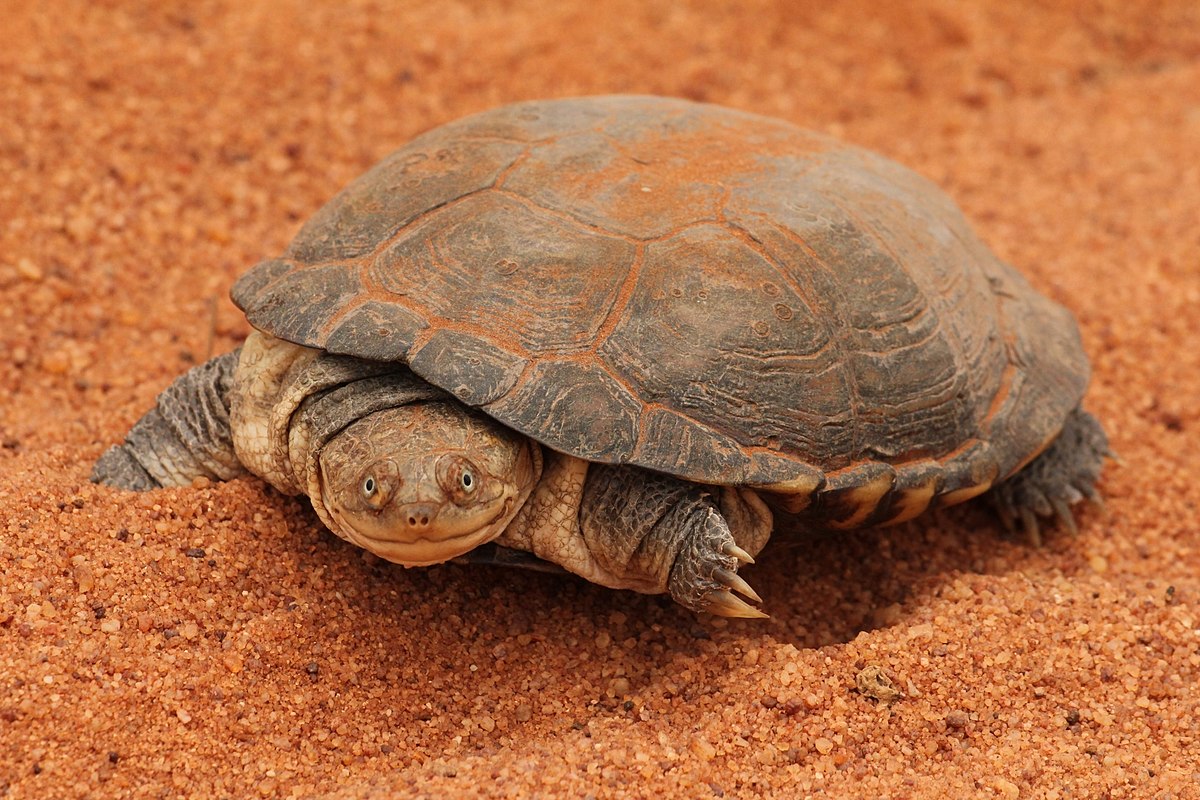
Widely distributed throughout Africa, including Madagascar, and parts of Asia, the African helmeted turtle is a small species characterized by its side-necked structure. Unfortunately, its conservation status remains uncertain.
This semi-aquatic turtle species thrives in both permanent and temporary bodies of water, but it exhibits a preference for stagnant water environments such as lakes, swamps, and rain puddles, rather than rivers. It goes by alternative names like “crocodile turtle” and “marsh terrapin.”
Within its habitat, the African helmeted turtle shares space with various iconic African animals, including crocodiles, warthogs, hippopotamuses, buffalos, and rhinos. In recent years, there have been documented instances of larger creatures contracting turtle-related infections from parasites found on the turtles’ bodies.
Unlike other members of the Pelomedusidae family, the African helmeted turtle lacks a hinged plastron, which prevents it from completely enclosing its head and front limbs within its shell by closing its plastron.
Alabama Red-Bellied Cooter

Native to North America, the Alabama red-bellied cooter is a critically endangered species of pond turtle. Its habitat is exclusively confined to the state of Alabama, making it a unique and cherished reptile within the region.
The distinct feature that distinguishes this turtle is its vibrant orange-red plastron, or lower shell, from which it derives its name. On average, females measure approximately 35.5 cm (14 inches) in length, while males tend to be slightly smaller, measuring around 30 cm (12 inches).
Thriving in freshwater and brackish waters, particularly in the lush vegetation of the Mobile-Tensaw River Delta, the Alabama red-bellied cooter has carved out its niche in this ecological setting. Its survival and well-being are intricately linked to this specific environment.
Alligator Snapping Turtle
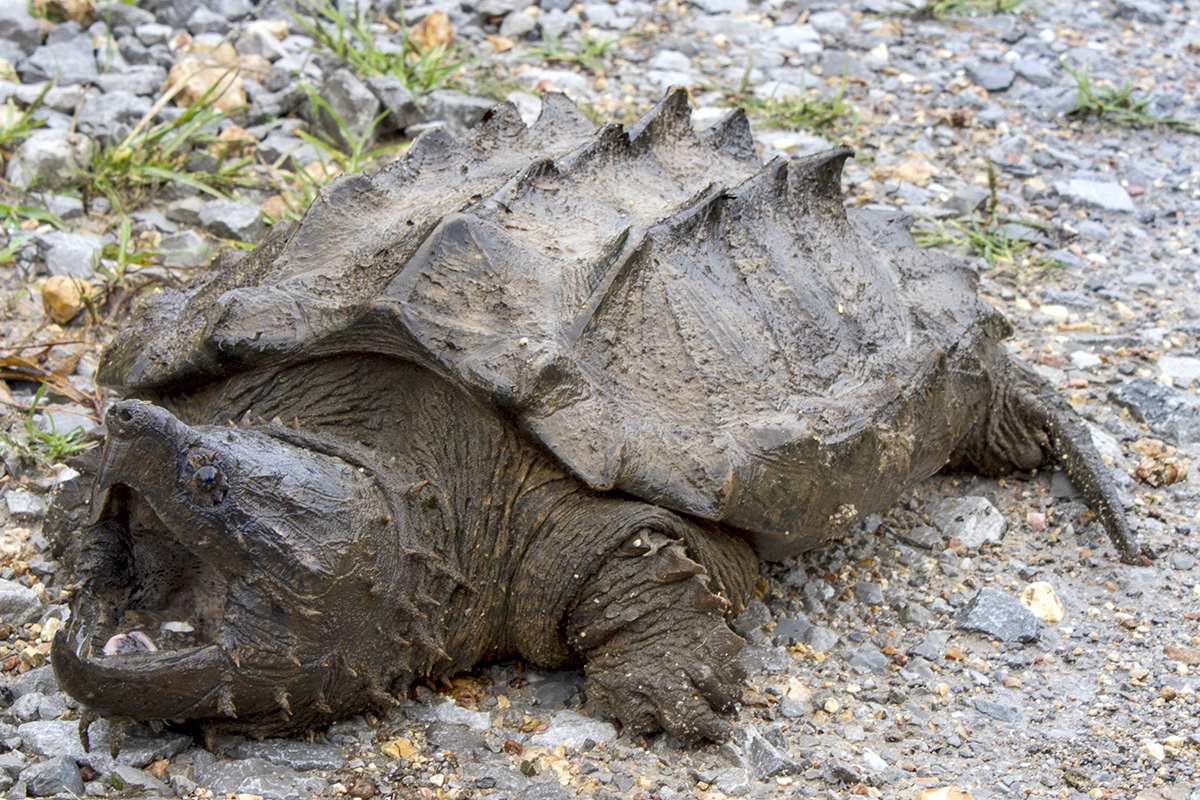
Renowned for its impressive size, the alligator snapping turtle stands as one of the largest freshwater turtle species worldwide, with individuals weighing over 100 kg (220 lb) and boasting a carapace length exceeding 80 cm (2.62 ft). Only certain softshell turtles from the Trionychidae family can rival or surpass its immense proportions.
Native to the southeastern United States, this turtle derives its name from its distinctive heavily ridged shell, reminiscent of an alligator’s appearance. It primarily inhabits rivers that flow into the Gulf of Mexico, carving out its niche in these aquatic habitats.
The feeding behavior of the alligator snapping turtle is remarkable and unconventional. In order to lure prey, the turtle adopts a patient approach, remaining motionless on the riverbed with its mouth agape, while enticing fish with its tongue’s worm-like tip.
Notably, this formidable turtle is not limited to piscine fare alone. It opportunistically consumes various other prey, including birds, snakes, small mammals, and even fellow turtles. Its arsenal comprises razor-sharp teeth capable of severing a human hand with ease.
Arrau Turtle / Giant River Turtle
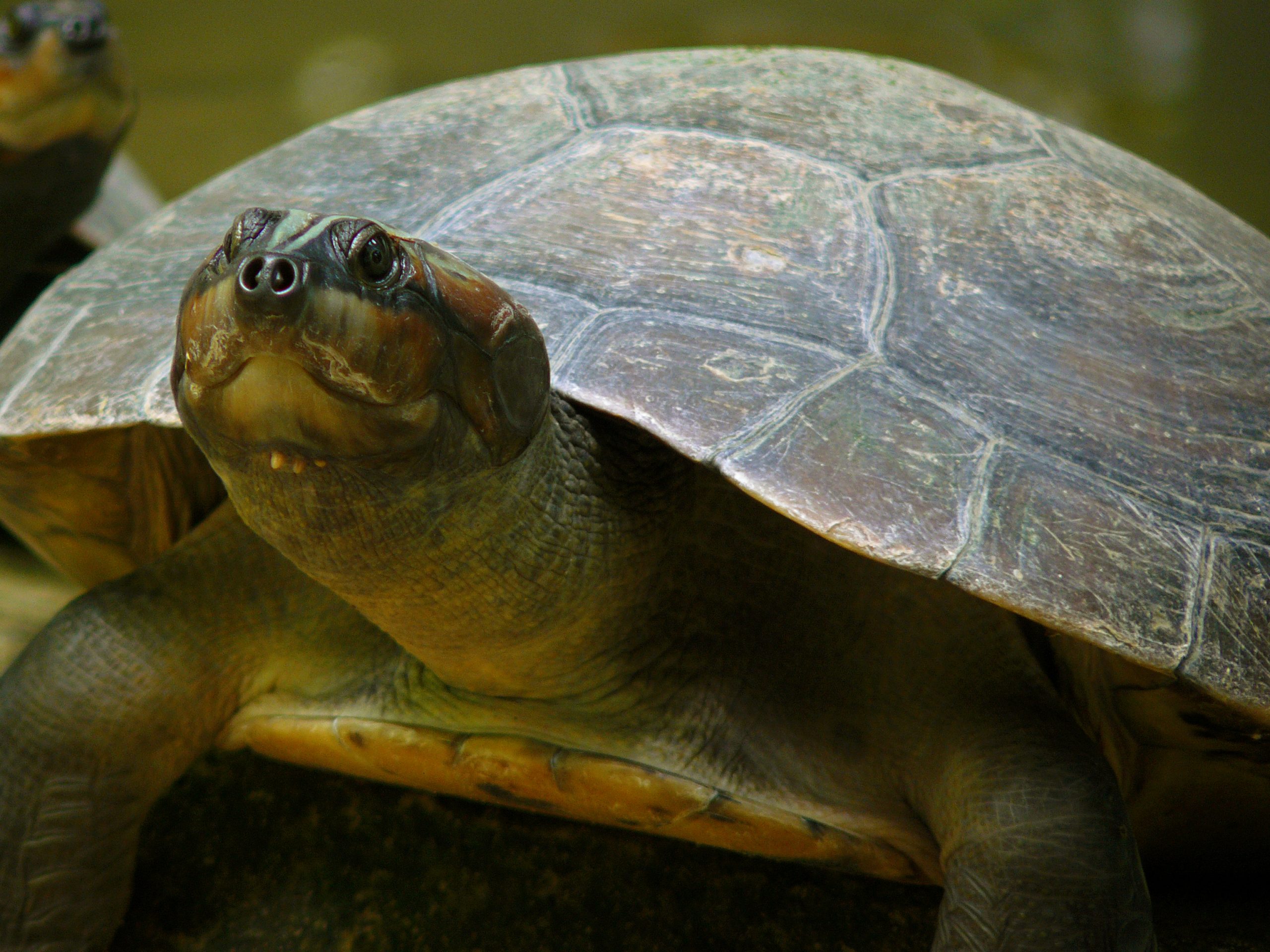
The Arrau turtle holds the distinction of being the largest side-neck turtle and non-marine turtle found in South and Central America. It belongs to the Podocnemididae family, which includes various turtle species.
Typically, the carapace length of this species measures around 90 cm (35 in). However, there have been reports of Arrau turtles weighing up to 100 kg (220 pounds), suggesting exceptional occurrences. As a generalist herbivore, the Arrau turtle primarily feeds on plant matter but may opportunistically consume carrion and smaller animals when available.
Unfortunately, the population of the Arrau turtle has suffered a significant decline in recent years. Once abundant along the banks of the Amazon and Orinoco rivers, it has become a victim of overhunting by locals, who hunt it for both its meat and eggs, even in areas where such practices are prohibited by law.
Asian Giant Softshell Turtle
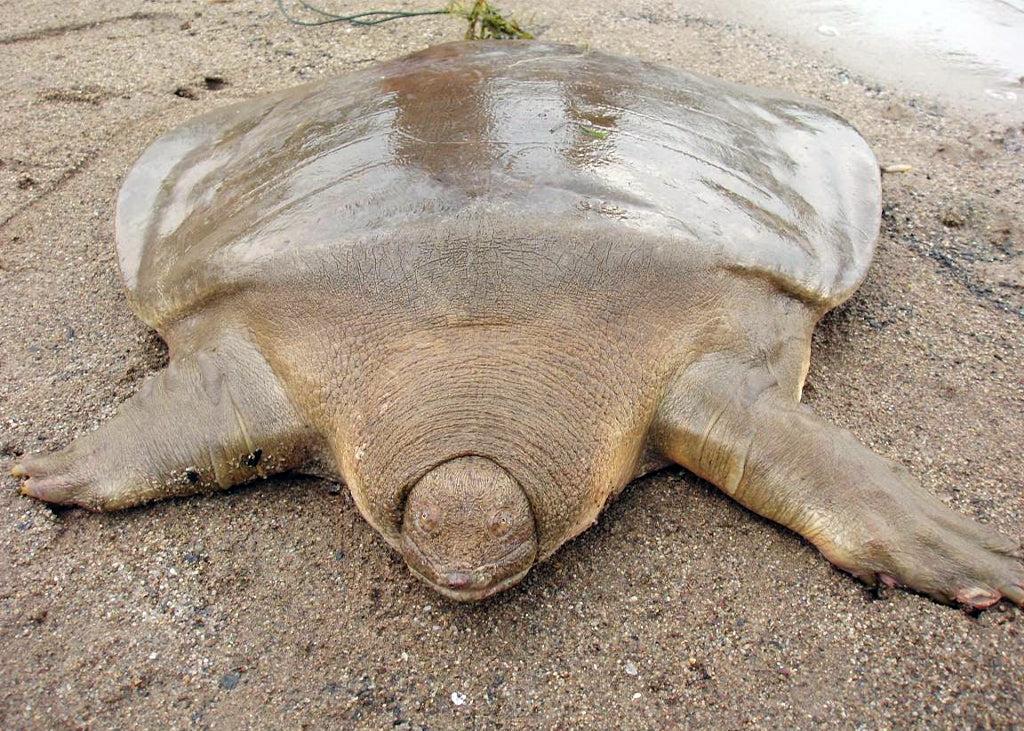
The Asian giant softshell turtle is an extremely endangered species belonging to the Trionychidae family, which comprises hidden-neck turtles. Known for its flat carapace devoid of scutes, this turtle possesses a smooth, leathery texture, much like other members of its family. While adult individuals display an olive green coloration, juveniles sport black specks on their shells and faces.
Among its family members, the Asian giant softshell turtle reigns as the largest, with a carapace capable of reaching lengths of up to 1 meter (3.28 feet). Females notably surpass males in size. Unofficial reports have even circulated, recounting extraordinary carapace lengths of up to 1.8 meters (5.9 feet). Currently, it shares the distinction of being the largest freshwater turtle with several other members of its family, solidifying its status as a true giant.
Predominantly carnivorous, the Asian giant softshell turtle occasionally consumes water plants but primarily relies on ambush hunting. It swiftly captures its prey by employing a rapid outward head movement combined with a powerful bite. Sadly, habitat degradation and the relentless consumption of both individuals and eggs by humans have led to a rapid decline in the species’ population. Immediate conservation efforts are crucial to its survival.
Big-Headed Turtle
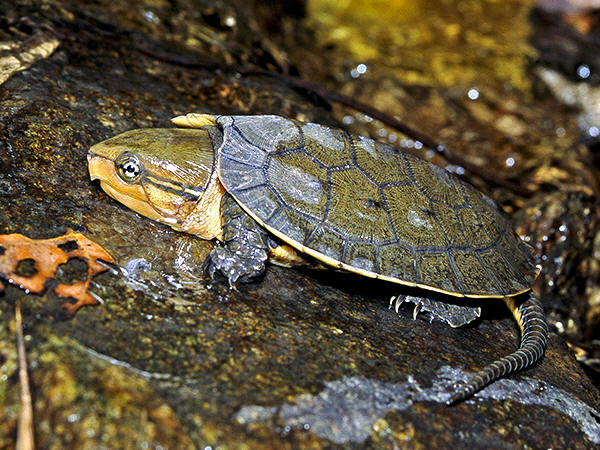
Residing in Southeast Asia, Platysternon megacephalum is a remarkable cryptodira, commonly known as the big-headed turtle. True to its name, this turtle exhibits a notably oversized head, which accounts for half of its average body length of 40 cm (16 inches), alongside its lengthy tail.
The turtle’s muscular and elongated tail serves a dual purpose: aiding in navigating obstacles and supporting the turtle’s entire body weight. Despite the inability of its head to retract into the shell, the big-headed turtle compensates with an exceptionally robust skull, providing some defense against potential threats.
When it comes to reproduction, the big-headed turtle lays a modest clutch of only 1 to 2 eggs per cycle. Unfortunately, limited knowledge is available regarding its specific reproductive habits. Regrettably, the species is classified as Critically Endangered due to various factors, including escalating demand in the illicit pet trade and widespread habitat destruction throughout its native range. Urgent conservation efforts are imperative to safeguard its future survival.
Common Box Turtle
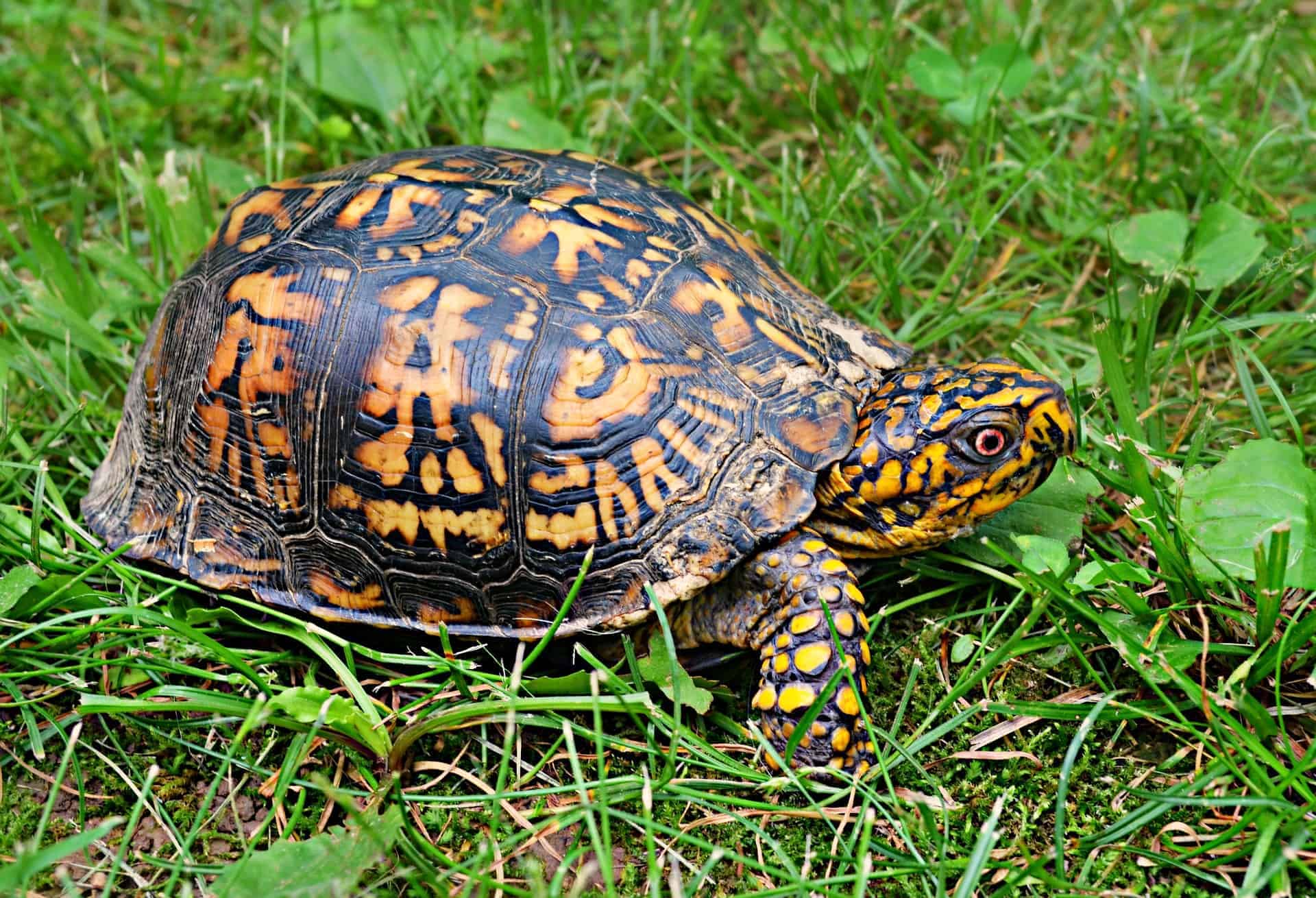
Belonging to the genus Terrapene, the common box turtle represents one of several species of box turtles within the Cryptodira suborder, known for their hidden-neck characteristic.
The Yucatán box turtle, sometimes considered a subspecies rather than a distinct species, is often referred to as the “eastern box turtle.”
A notable feature of box turtles is their hinged plastron, enabling them to retract and close their shell for protection against predators. Like all box turtles, the common box turtle predominantly dwells on land, displaying a terrestrial lifestyle. Its habitat encompasses southern Canada, the eastern United States, and northern Mexico.
These turtles exhibit a preference for forests, shrublands, and inland wetlands as their natural habitats. Notably, subspecies of the common box turtle include the eastern box turtle, Florida box turtle, and Mexican box turtle.
Common Musk Turtle

The common musk turtle, often referred to as the “stinkpot,” earns its name due to its ability to release a pungent, yellowish fluid from scent glands situated on its underside. This little turtle showcases a smooth, high-domed shell, typically measuring between 7.5 to 14 cm (3 to 5.5 inches) in length. Notably, it exhibits two distinct yellow stripes on each side of its head.
The common musk turtle finds its habitat in southern Canada and various regions across the eastern United States. Unlike similar species, it tends to spend less time basking under the sun and can be found in both flowing and still freshwater environments. When it comes to sustenance, this turtle relies predominantly on mollusks, which constitute a significant portion of its diet.
Common Snapping Turtle

Scientifically known as Chelydra serpentina, the common snapping turtle belongs to the Cryptodira suborder, which comprises hidden-neck turtles. It falls under the Chelydridae family. The species is primarily found in North America, but it has also been introduced in parts of Asia. Currently, its conservation status is classified as of low concern. The common snapping turtle is the sole snapping turtle species present in the United States and Canada, and it holds the widest distribution among the three species.
Snapping turtle eggs and hatchlings face threats from various predators, but once they reach a certain size, they become relatively secure from predation. Adult snapping turtles have been documented as prey for bears, alligators, and river otters. These turtles are solitary creatures, and they display aggression when provoked or unhappy. They are known to exhibit territorial behavior, even decapitating other turtles with their powerful jaws.
As omnivores, common snapping turtles have a diverse diet. They consume aquatic plants, scavenge for carrion, and actively hunt a range of animals, including waterfowl and small mammals. Employing an ambush strategy, they patiently wait for their prey to approach before launching a sudden attack.
While individual specimens may vary in size, the common snapping turtle can attain a maximum carapace length of 50 cm (19 inches) and reach a maximum weight of 35 kg (77 lb). The tail, shell, and body of this species are approximately equal in length.
Desert Tortoise
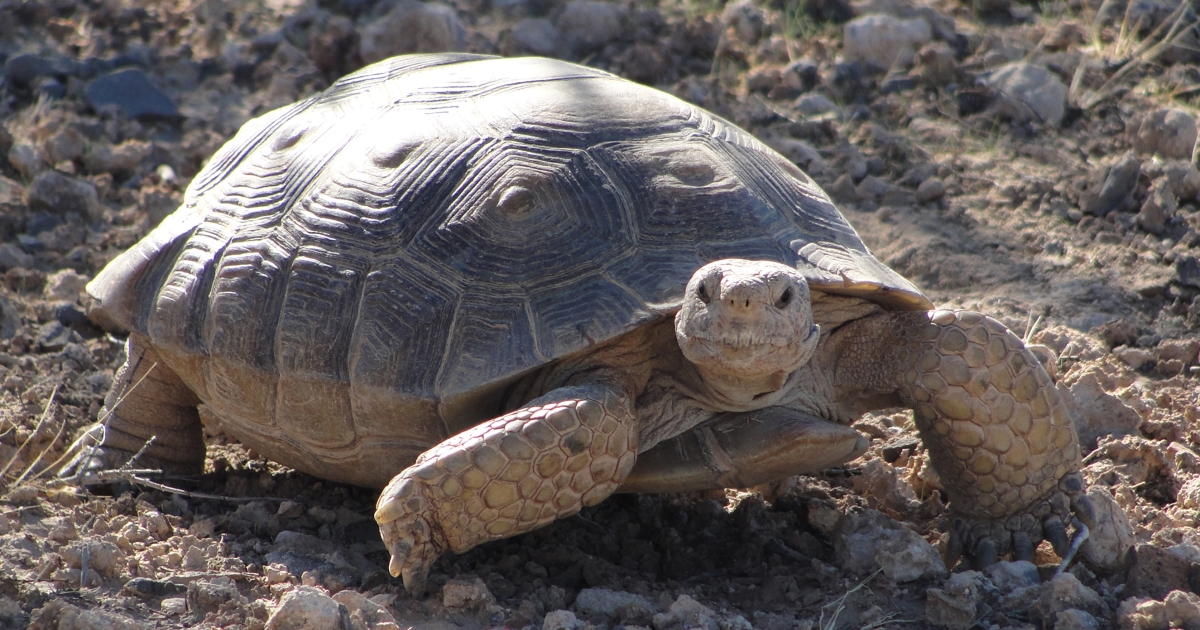
The desert tortoise is a native species of the United States, belonging to the Cryptodira suborder, which includes hidden-neck turtles. Its natural habitat encompasses the dry shrublands of California, Nevada, Utah, and Arizona.
Female desert tortoises lay one clutch of eggs per year, with each clutch typically containing 1 to 14 eggs (averaging around 3 to 5 eggs). The yolk within the eggs provides essential nutrients for the developing embryo, sustaining it not only during incubation but also for up to 6 months after hatching.
As herbivores, desert tortoises spend a significant portion, about 95 to 98%, of their lives underground. Equipped with long claws, they are proficient diggers, while their large teeth aid in their herbivorous diet.
Males generally weigh around 20 kg (44 pounds), while females have a slightly lower weight, with an average of approximately 13 kg (28 pounds). Both sexes exhibit similar shell lengths, ranging from 25.4 to 40 cm (10 to 15.7 inches).
The desert tortoise faces critical endangerment primarily due to habitat loss and fragmentation caused by human activities. These factors pose significant threats to the survival of this species.
Diamondback Terrapin / Terrapin
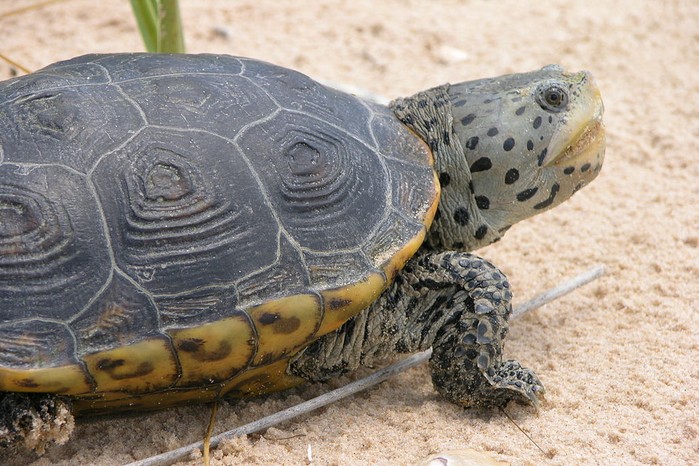
The diamondback terrapin is a species of hidden-neck turtle, belonging to the Cryptodira suborder. It can be found along the eastern and southern coasts of the United States, residing in brackish waters instead of the more common freshwater habitats seen among reptiles.
To prevent dehydration, the diamondback terrapin must remain in proximity to freshwater sources. Similar to sea turtles, female terrapins seek out nesting sites above the high tide line on beaches. During the months of April through July, they lay clutches of eggs, typically ranging from 4 to 18 (with some studies suggesting up to 25) eggs. The incubation period for these eggs spans approximately 80 to 90 days.
One of the primary threats faced by the diamondback terrapin, across much of its range, is accidental capture in crab pots intended for catching blue crabs, a popular edible crustacean. These terrapins unwittingly enter the crab pots and are unable to escape, resulting in their demise. Loss of breeding habitats due to agricultural and residential expansion, as well as incidents involving collisions with vehicles and boats, are additional contributing factors to the decline of the diamondback terrapin population.
East African Black Mud Turtle

The East African black mud turtle, also known as the Pan terrapin and the black-bellied hinged terrapin, is a turtle species indigenous to Africa. It is primarily found in the eastern and southeastern regions of the continent, particularly in tropical and sub-tropical areas.
This species displays a mostly smooth carapace with distinct yellow lines along its margins, measuring between 13 to 20 cm (5.1 to 7.9 inches) in length.
Being an omnivorous creature, the East African black mud turtle feeds on a varied diet that includes fish, invertebrates, and plants. It exhibits heightened activity during nighttime. While it can be handled with relative ease, this species tends to be aggressive towards other turtles. As such, it can be kept as a pet, but careful consideration must be given to its compatibility with other turtle species.
Eastern Long-Necked Turtle
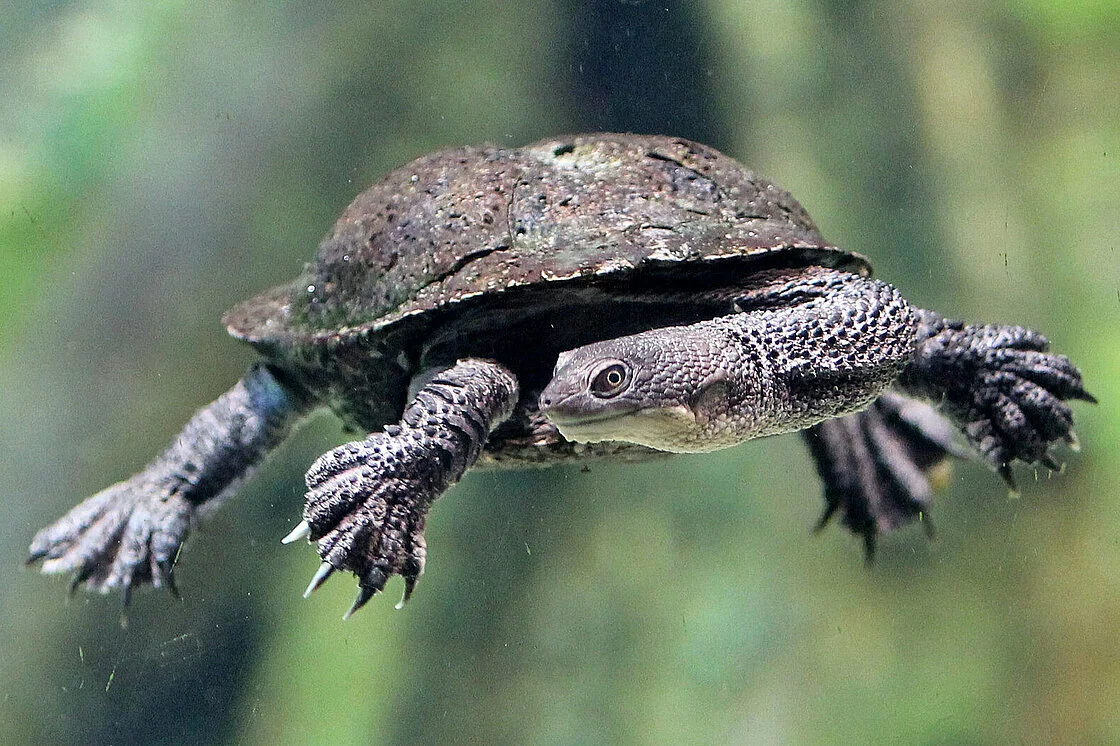
Chelodina longicollis, a freshwater turtle native to the southeastern region of Australia, stands out for its distinctively long neck, from which it derives its name. When the turtle extends its head and neck, it can add an additional 25 cm (9.84 inches) to its overall length.
The eastern long-necked turtle boasts a lifespan that can reach up to 37 years. Its diet consists of a variety of prey, including fish, mollusks, crustaceans, tadpoles, and other aquatic invertebrates. Additionally, it occasionally captures terrestrial insects.
When faced with threats from predators, this species employs intriguing defense mechanisms. It has the ability to release a noxious yellow fluid from its musk glands, emitting an unpleasant odor to deter potential attackers. Furthermore, when sensing danger, the eastern long-necked turtle can retract its head and jaws into its shell, utilizing its protective armor as a shield against approaching predators.
False Map Turtle
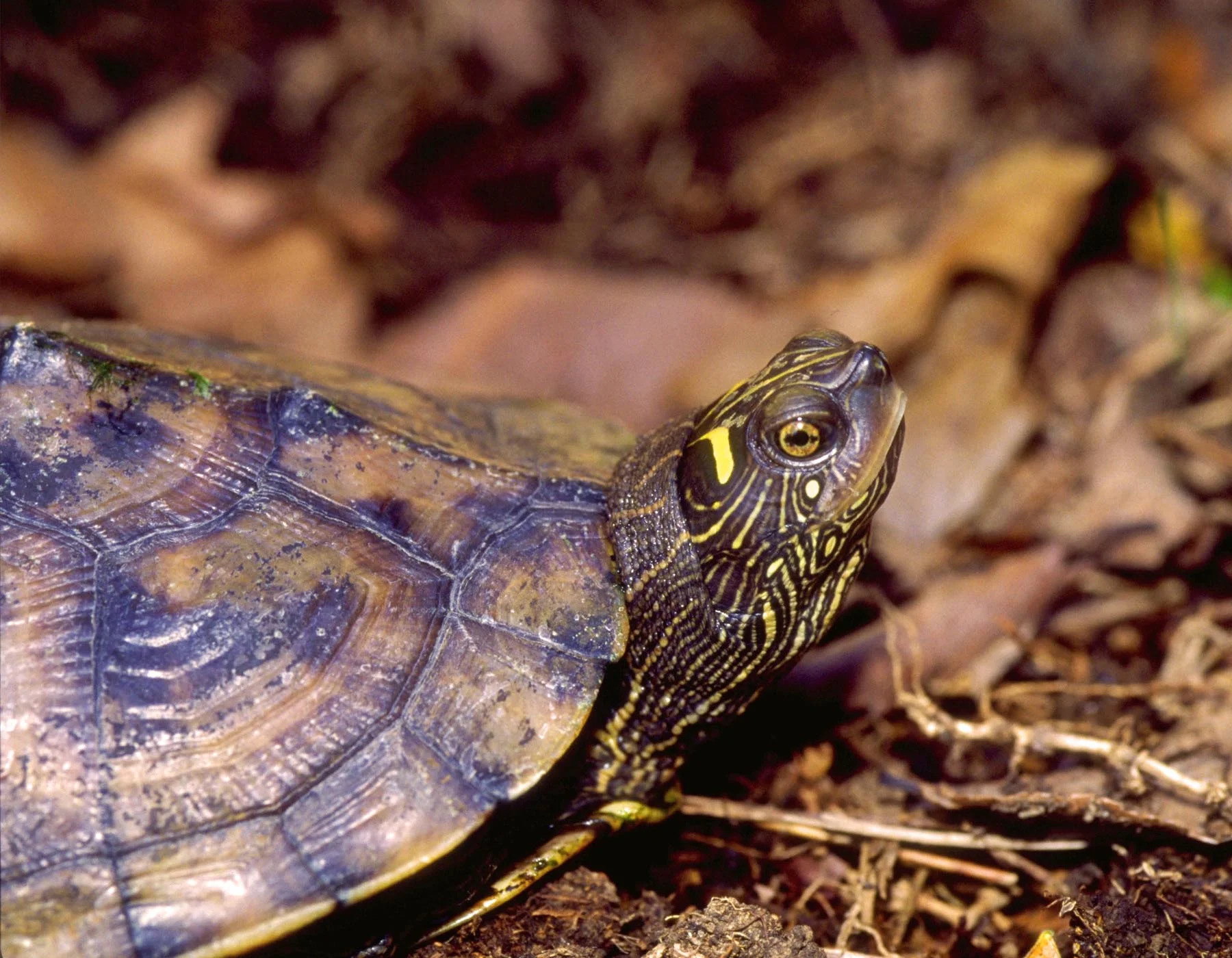
Belonging to a group of turtles known as map turtles, the false map turtle is one of the 14 species within this category. Map turtles are named for their distinctive patterned markings that resemble maps. In the Mississippi-Missouri basin, the false map turtle can be found dwelling in large streams. It is also referred to as the Mississippi map turtle.
There is a notable size difference between the female and male false map turtles. Females typically measure around twice the length of the males, ranging from 20 to 27 cm (7.9 to 10.6 inches), while males measure between 9 to 14 cm (3.5 to 5.5 inches).
Similar to other turtle and tortoise species, false map turtles exhibit temperature-dependent sex determination. This means that the temperature during incubation determines the sex of the hatchlings. Colder nests tend to produce all-male clutches, while warmer nests result in all-female clutches.
Florida Softshell Turtle
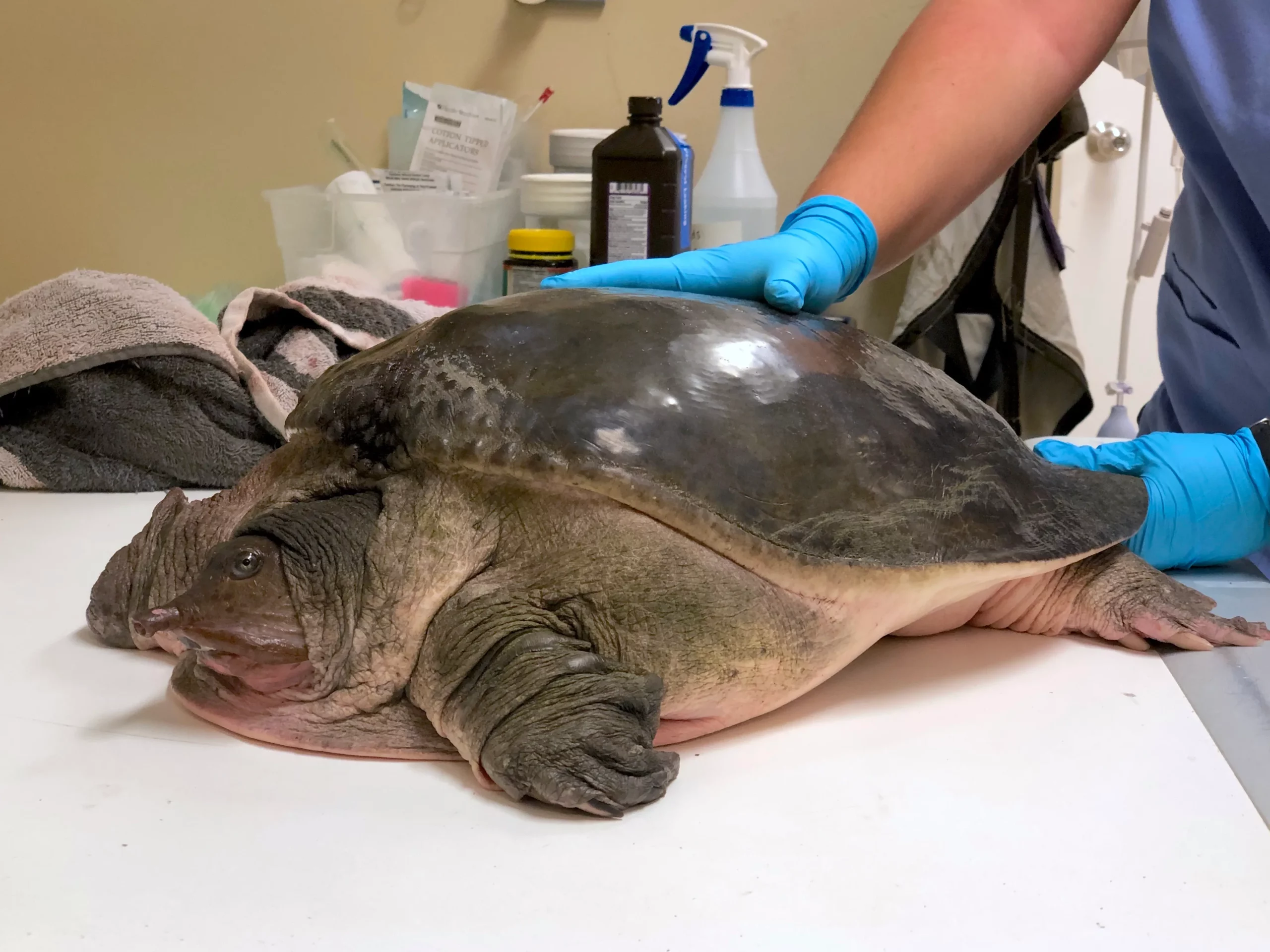
The Florida softshell turtle holds the distinction of being the largest member among the Trionychidae family of softshell turtles, which are found in North America. This species specifically inhabits slow-moving or stagnant bodies of freshwater in Florida, Georgia, South Carolina, and Alabama. It is endemic to the United States, meaning it is exclusively found within its borders.
Unlike most other turtle and tortoise species, the sex of Florida softshell turtle hatchlings is purely determined by genetics and remains unaffected by nest temperature. Individuals of this species display a wide range of hues, ranging from dark olive green to brown, with the Florida population being notably darker. White plastrons, the underside of the shell, are common among individuals.
The Florida softshell turtle possesses a leathery and pliable shell, distinct from the rigid, bony scutes found in other turtle species. Notably, females of this species are considerably larger, up to four times the size of males, exhibiting sexual dimorphism. The size of a female’s clutch of eggs is believed to be proportionate to her size.
Four-Eyed Turtle
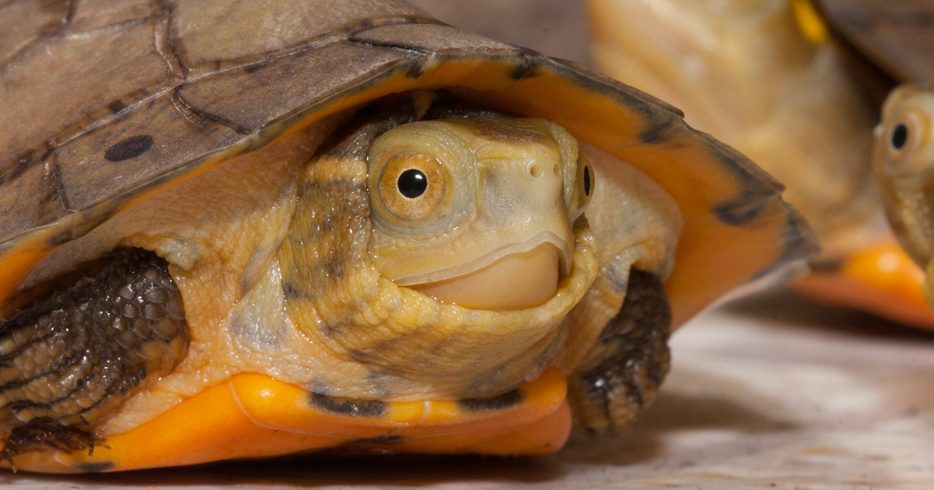
The four-eyed turtle belongs to the Geoemydidae family and is primarily found in East and Southeast Asia. This unique species is critically endangered due to its distinct feature of having two, and sometimes even four, false eye spots located on the back of its head.
Both males and females of the four-eyed turtle reach a length of approximately 11 to 15 cm (4.3 to 5.9 inches). The male individuals exhibit blue-green eye specks, while the female individuals display yellow ones.
Sadly, the population of this species is rapidly declining, mainly due to exploitation in Asian cuisine and traditional medicine practices. Additionally, the capture of wild turtles for the exotic pet trade has further contributed to its endangerment. Habitat loss is another significant factor affecting the four-eyed turtle’s survival.
The carapace, or shell, of this omnivorous species is yellow-tan in color. Interestingly, they appear to coexist peacefully with other creatures, including members of their own species, despite being solitary animals that only come together during the breeding season.
Green Sea Turtle
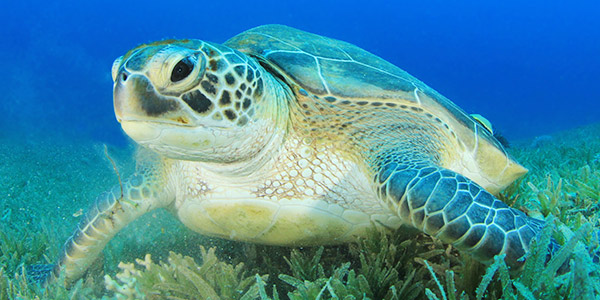
The green sea turtle is renowned as the largest hard-shelled sea turtle, weighing around 200 kg (440 lb). It is second in size only to the leatherback sea turtle, which possesses a leathery carapace. One distinctive feature of the green sea turtle is the presence of green fat beneath its carapace, lending it a dark olive coloration.
Reaching sexual maturity can take up to 50 years for green sea turtles. Females exhibit remarkable nesting behavior, returning to the very beach where they themselves were hatched to lay their clutches of eggs. Unfortunately, statistics indicate that only a mere 1 out of every 1000 hatchlings manages to survive beyond their first year, highlighting the challenges they face during early life stages.
As juveniles, green sea turtles have an omnivorous diet, but as they grow and mature, their eating habits gradually shift towards herbivory. Once they reach a certain size, they primarily feed on plant matter. This species displays highly social behavior and can travel considerable distances in a day, with groups covering up to 90 kilometers (55.9 miles).
Hickatee

The Hickatee, also known as the Central American river turtle, exclusively inhabits Atlantic-draining rivers and lakes spanning from southern Mexico to Belize and Guatemala. It thrives primarily in large, deep rivers and lakes during the rainy season when water levels are higher, although it may venture into other areas as well.
This species is fully aquatic and does not leave the water, even for basking. It possesses a clumsy and sluggish walking ability, only emerging from the water to nest. Locating the nests of the elusive Hickatee proves challenging for humans.
Remarkably, the eggs of the Hickatee exhibit exceptional durability, capable of remaining submerged for weeks. This adaptation increases the chances of nest survival, particularly in flood-prone areas. In ancient Mayan times, the Hickatee faced near-extinction due to hunting, as it held cultural significance to the Mayan civilization.
Unfortunately, the Hickatee remains one of the most endangered turtle species within its range, and its situation has not improved since it was targeted for food. Despite turtle hunting being permitted solely in Belize, there remains a high risk of the Hickatee’s extinction.
Leatherback Sea Turtle
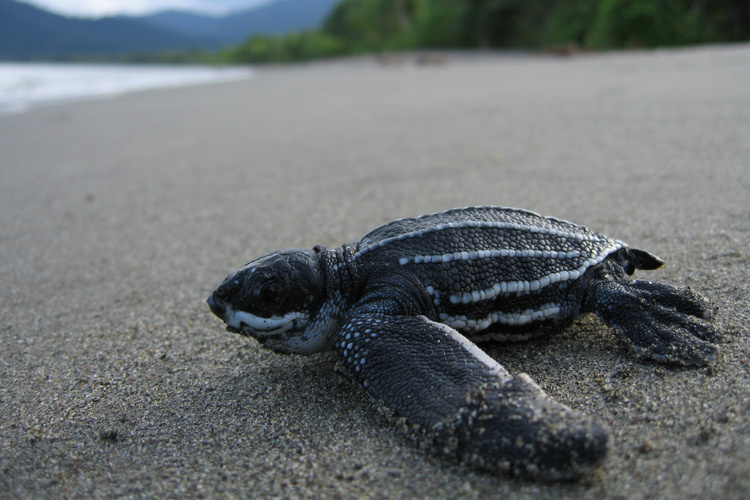
The leatherback sea turtle, belonging to the Cryptodira suborder, holds the distinction of being the world’s second-largest marine reptile, surpassed in size only by the saltwater crocodile. This remarkable species can reach lengths of up to 1.8 meters (6 feet) and weigh over 450 kg (1000 lb).
Unlike other turtles with hard, bony scutes, the carapace of the leatherback sea turtle is smooth and lacks these prominent features. It earns its name from the carapace, which possesses a firm yet pliable, leathery texture.
Among turtles, the leatherback boasts the most unique shell, known for its leathery composition. With the exception of Antarctica, the leatherback sea turtle has a “cosmopolitan” distribution, encompassing vast stretches of the world’s oceans.
As a migratory species, the leatherback sea turtle spends the majority of its time in open water and only comes ashore to lay eggs. However, due to habitat destruction and hunting activities, the leatherback turtle is classified as vulnerable, facing significant threats to its survival.
Malaysian Giant Turtle
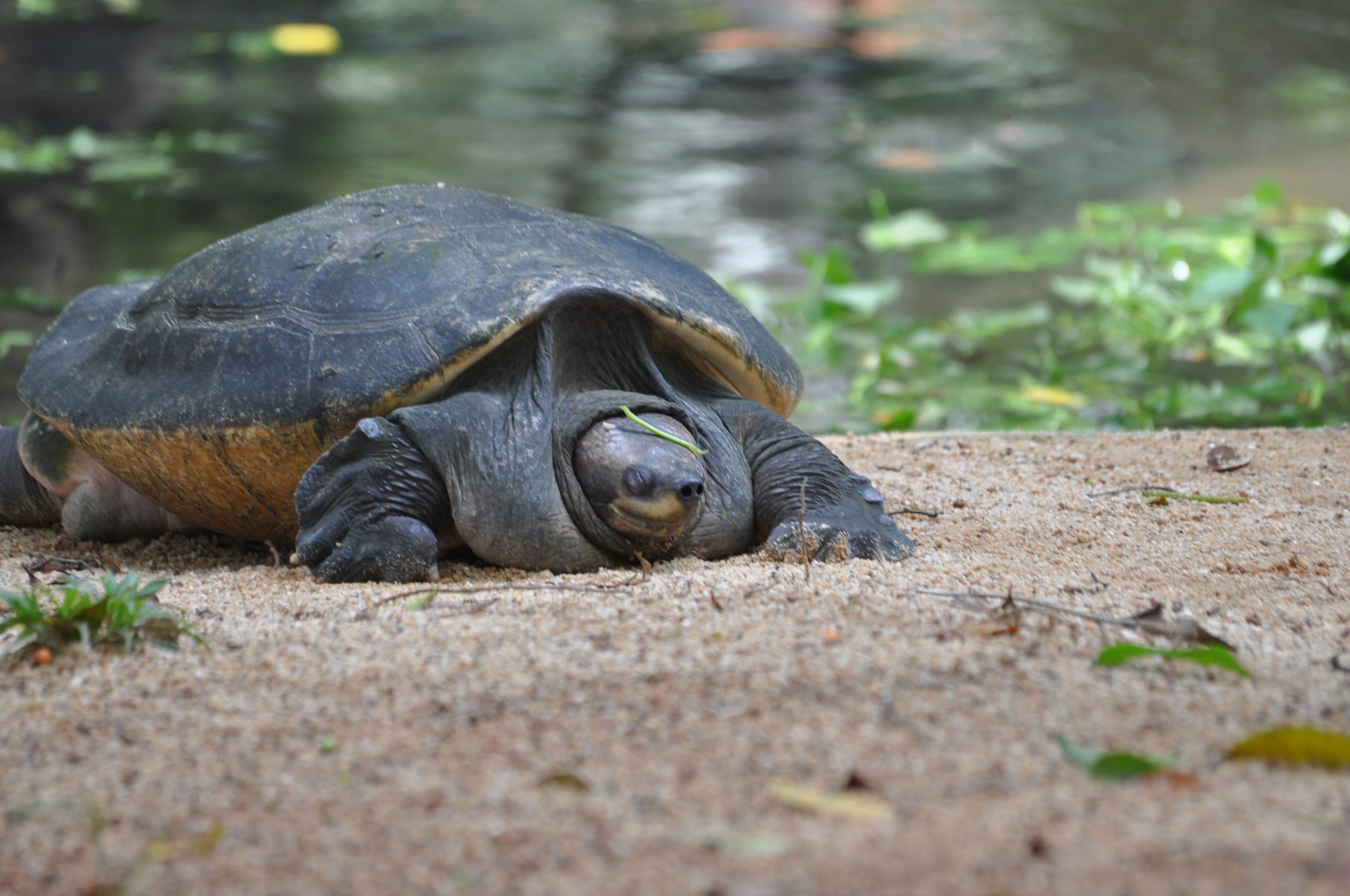
Scientifically known as Orlitia borneensis, the Malaysian Giant Turtle is a prominent member of the Geoemydidae family within the Cryptodira suborder of hidden-neck turtles. This species is predominantly found in Indonesia and Malaysia, with a conservation status classified as Critically Endangered.
As one of Southeast Asia’s largest turtle species, the Malaysian Giant Turtle can weigh up to 50 kg (110 lb). It inhabits various freshwater habitats, including marshes, lakes, and rivers in Peninsular Malaysia, as well as the islands of Borneo and Sumatra.
The diet of the Malaysian Giant Turtle primarily consists of fish, although it also consumes small invertebrates and fallen fruit. Unfortunately, this species faces significant population decline due to hunting activities and habitat destruction.
Hunters target both the meat and shell of the Malaysian Giant Turtle, utilizing them for traditional Chinese medicine purposes. The expansion of the palm oil industry has played a detrimental role in habitat destruction across Malaysia. Extensive deforestation to make way for palm oil plantations has led to the loss of crucial rainforest habitats, contributing to the endangerment of numerous species, including the Malaysian Giant Turtle.
Painted Turtle

The Painted Turtle is widely distributed throughout North America, inhabiting ponds and lakes, and it holds a least-concern conservation status. Its range spans across the United States, southern Canada, and northern Mexico, making it one of the most prevalent turtle species on the continent.
Measuring between 12 and 25 cm (5 and 10 inches) in length, the Painted Turtle showcases sexual dimorphism, with females typically being slightly larger than males. Its name perfectly reflects its appearance, as it displays vibrant yellow and red markings.
Although primarily aquatic, this species often basks in the sun on logs or rocks, frequently venturing out of the water. Its diet is omnivorous, encompassing both plant matter and small creatures.
During the winter months, the Painted Turtle undergoes hibernation by burying itself in the mud at the bottom of a lake. This unique adaptation allows the species to inhabit environments that would be unsuitable for other reptiles.
Remarkably, the Painted Turtle serves as a well-studied example of a vertebrate capable of surviving without oxygen for prolonged periods while buried in the mud, as it does not breathe during this time.
Pig-Nosed Turtle
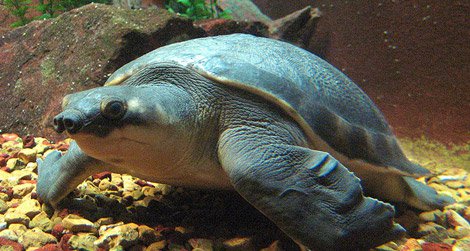
Carettochelys insculpta, commonly known as the pig-nosed turtle, is found in the northern regions of Australia and southern New Guinea. It belongs to the Cryptodira suborder, characterized by hidden-neck turtles.
The pig-nosed turtle derives its name from its distinctive, pig-like snout, which serves as a sensitive tool for locating food. It primarily inhabits freshwater marshes and rivers in northern Australia.
Unlike typical freshwater turtles, the pig-nosed turtle possesses flippers instead of feet, resembling marine turtles in this aspect.
Although classified within the Trionychidae superfamily, which includes soft-shell turtles, the pig-nosed turtle possesses a unique feature. Beneath its leathery skin, it possesses a bony carapace, distinguishing it from other members of this group that typically exhibit a flat plate structure.
Pond Slider
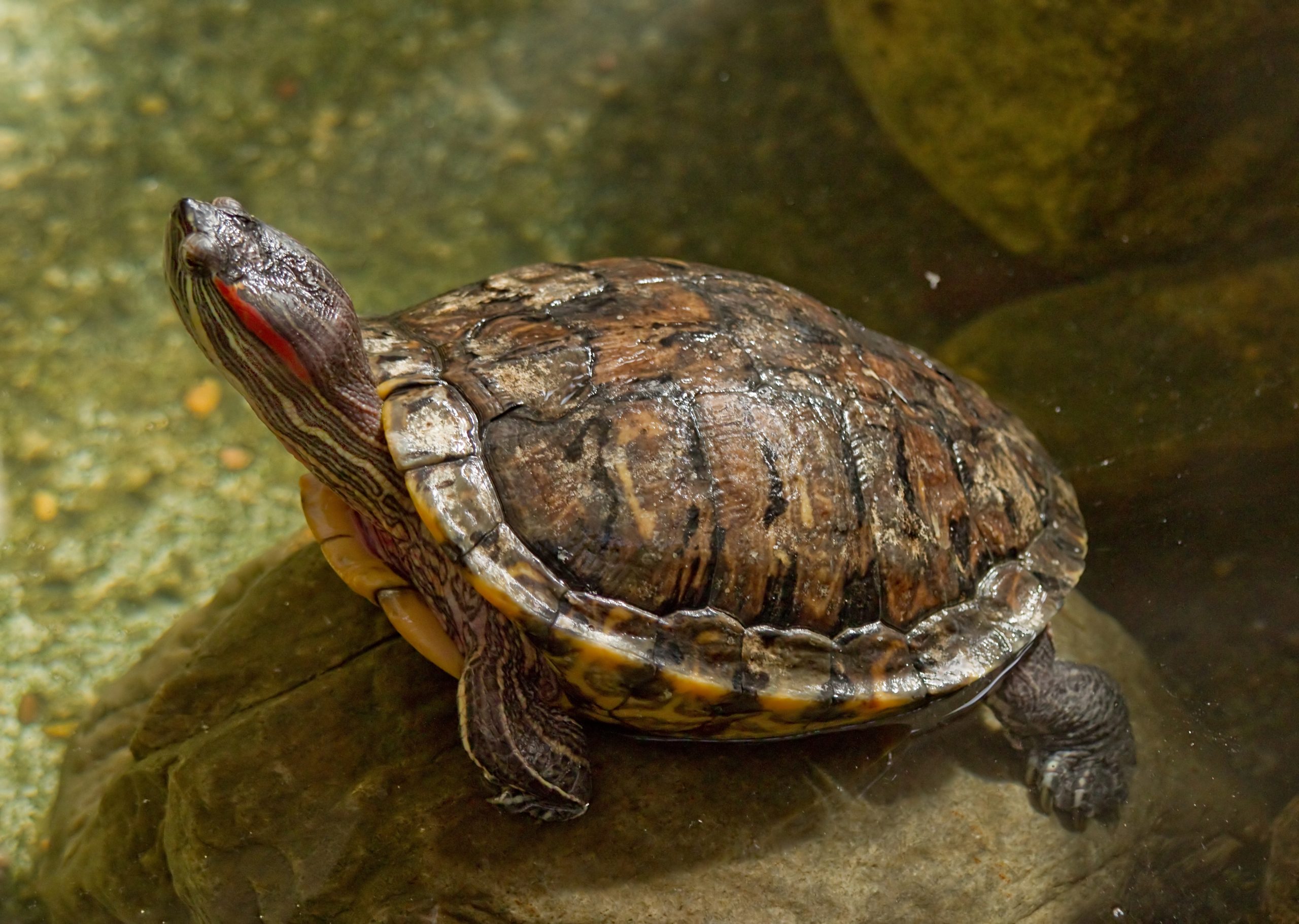
Trachemys scripta, a species of hidden-neck turtle, can be found in the United States and northern Mexico. The pond slider, a protected species, is a specific type of turtle that inhabits the southern and southeastern regions of the United States, as well as northern Mexico.
Among the three subspecies, the red-eared slider is the most well-known, accompanied by the yellow-bellied and Cumberland sliders.
The name “pond slider” stems from the turtle’s tendency to slide off rocks and logs into the water. This species is semi-aquatic, spending time both on land and in the water.
Due to its small size and gentle temperament, the pond slider has gained popularity as a pet turtle not only within its native North America but also in various other parts of the world.
However, this popularity has led to its establishment outside its natural habitat. When released as pets are not handled properly, they can pose a threat to native turtles and other species. It is crucial to exercise caution to prevent harm to the ecosystem when dealing with released pet turtles.
Roti Island Snake-Necked Turtle
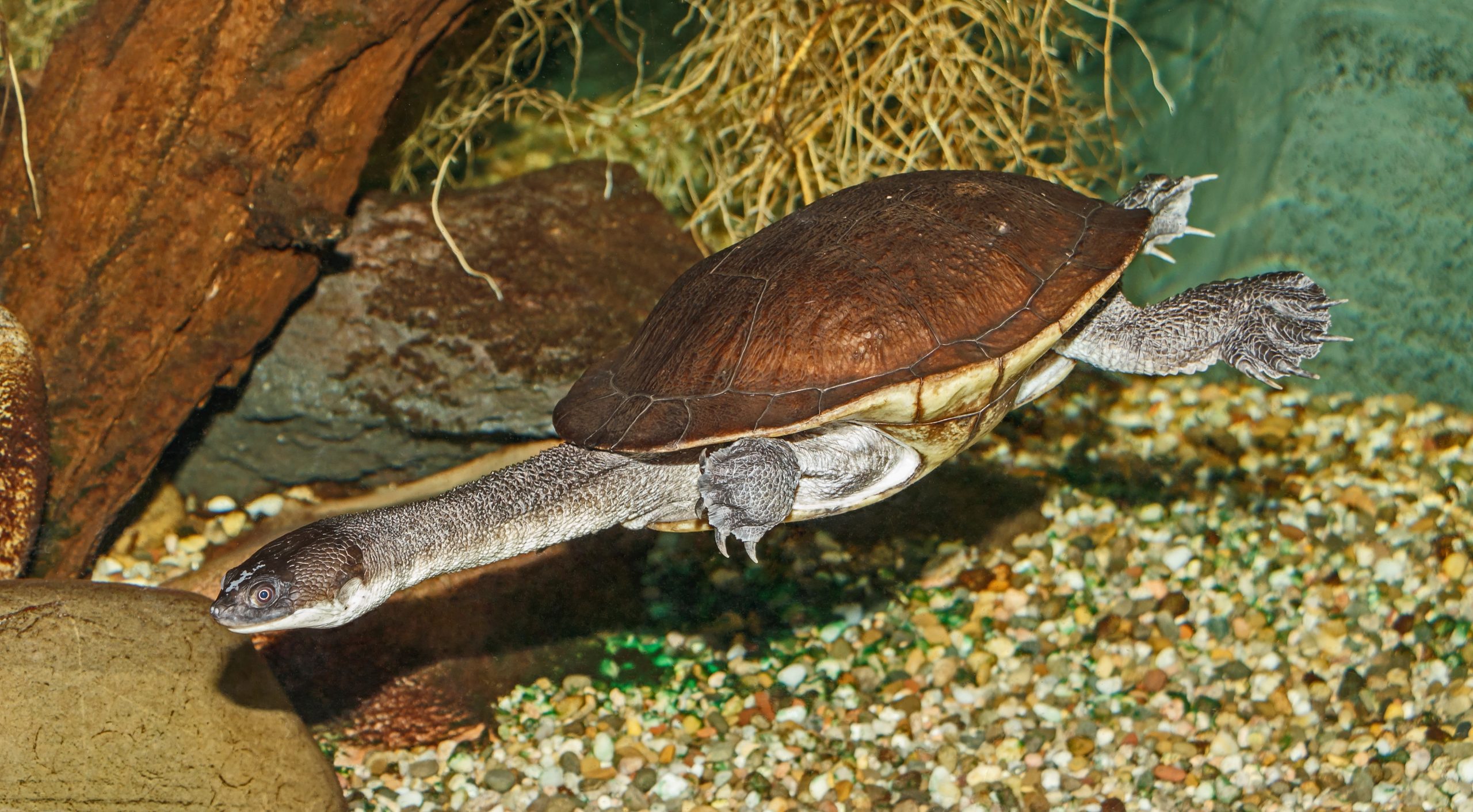
The Roti Island snake-necked turtle belongs to the Chelidae family and is native to two islands in Southeast Asia: Rote, which is part of Indonesia, and Timor.
Unfortunately, in the wild, the critically endangered turtle is believed to be extinct on Rote Island. The distinguishing feature of the Roti Island snake-necked turtle is its exceptionally long neck, which can almost match the length of its carapace.
This unique turtle species has become a highly sought-after target for poachers due to its distinct appearance, making it valuable in the illegal pet trade. Despite its critically endangered status, efforts have been made to establish captive breeding programs aimed at conserving and preserving this species. (Source)
Spiny Softshell Turtle
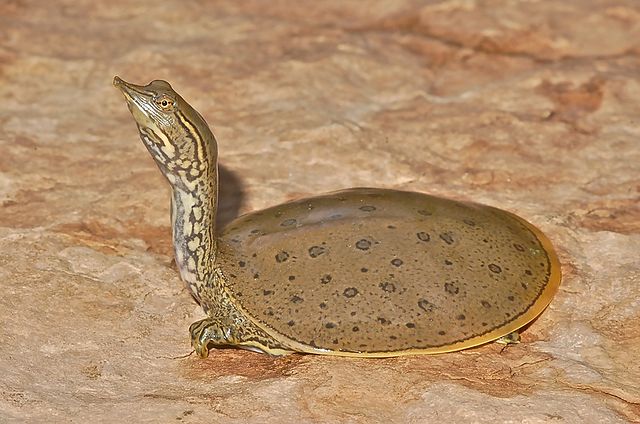
The Apalone spinifera, a freshwater turtle, can be found across North America. It belongs to the Cryptodira suborder, characterized by hidden-neck turtles. This species is known for its distinct features, including a leathery and soft-textured shell adorned with short spines along the front edge. Another distinguishing characteristic is its long and snout-like nose.
The Spiny Softshell Turtle is among the largest freshwater turtles on the continent, with a carapace length reaching approximately 54 cm (21 inches). Females, in particular, tend to be slightly larger than males, attaining this impressive size.
Unlike many other turtles that are often shy and solitary, the Spiny Softshell Turtle displays a sociable nature and can frequently be observed basking in the sunlight. What sets this species apart is its ability to “breathe underwater” through its skin, allowing it to take in oxygen and release carbon dioxide while submerged, making it unique among freshwater turtles.
Spotted Turtle
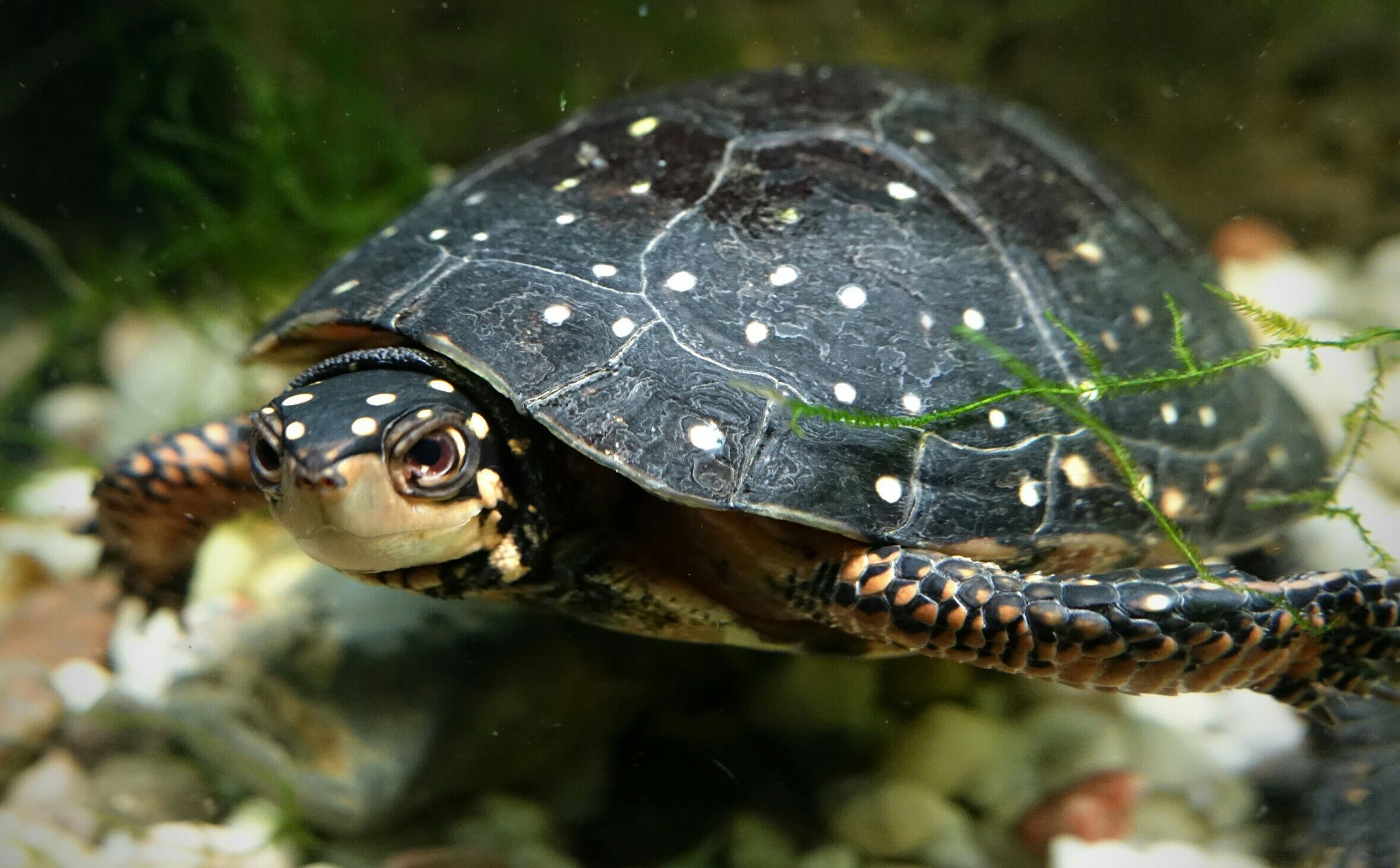
The Clemmys Turtle, a small semi-aquatic species, can be found in various wetlands across North America, including ponds, marshes, and similar habitats. It possesses a black or dark brown carapace adorned with yellow markings, typically measuring between 9 and 13 cm (3.5 to 5 inches) in length.
The spotted turtle is known for its shy and reserved nature, often spending a significant portion of its time concealed in the muddy depths of ponds and streams. As an omnivorous species, its diet comprises small aquatic creatures like insect larvae and tiny fish, as well as plant materials such as fruits and algae.
Sadly, the spotted turtle faces numerous threats, including hunting, vehicle collisions, and habitat destruction. These factors contribute to the species’ vulnerable status and pose challenges to its survival.
Striped Mud Turtle

The Striped Mud Turtle, a small and sturdy turtle, can be found in North America. It displays a dark brown or black shell adorned with yellowish stripes. Like other turtles in the Kinosternidae family, such as mud and musk turtles, its carapace features a noticeable keel running along the center.
This species, known as the striped mud turtle, is commonly found in southern states where there are calm and slow-moving bodies of water. It is often observed while diving to search for food.
As an omnivorous turtle, the striped mud turtle has a varied diet that includes insects, snails, small fish, plants, and algae. Its feeding habits play a crucial role in the ecosystem by helping to control the population of its prey species.
Western Box Turtle / Ornate Box Turtle

The Terrapene ornata, commonly known as the western box turtle, is a species belonging to the Cryptodira suborder of hidden-neck turtles. It is part of the Emydidae family and is classified as Near Threatened.
Box turtles are terrestrial turtles that resemble tortoises. The western box turtle is found in a region extending from west of the Mississippi to the eastern Rockies and south into northern Mexico.
These turtles are often discovered far from water bodies, residing in prairies, pastures, and open woodlands. Male western box turtles have red eyes and a red or orange patch on their throats, while females have brown eyes and lack the neck patch. The coloring differences allow for differentiation between males and females.
Although the population of western box turtles is not currently endangered, it is facing a decline. The conversion of grasslands into farmland has resulted in significant habitat loss for these turtles.
The western box turtle faces additional threats such as being struck by vehicles or farm equipment and being captured from the wild for the pet trade. These factors contribute to its vulnerable conservation status.
Among the common box turtles, the ornate box turtle inhabits the Great Plains region of the United States, while the desert box turtle is found in the southwestern United States and Mexico.
Western Swamp Turtle
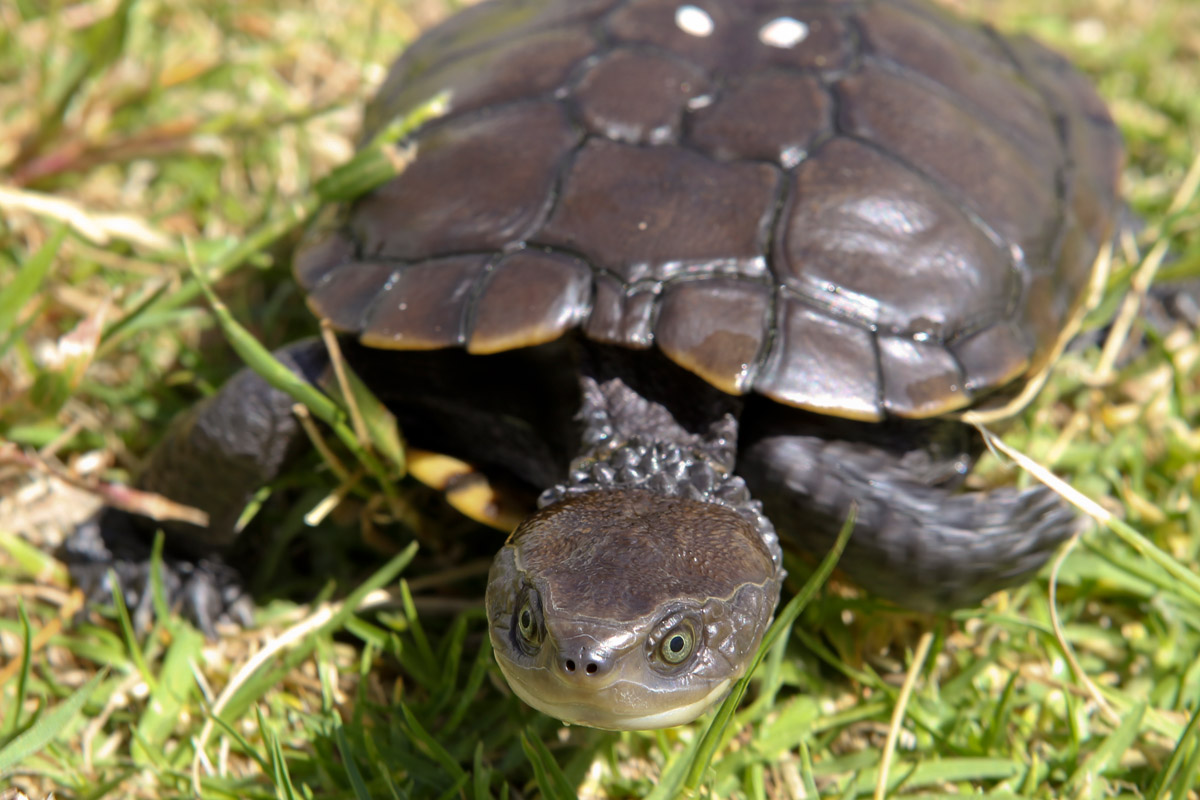
The Pseudemydura umbrina, commonly known as the Western Swamp Turtle, belongs to the Pleurodira suborder of side-necked turtles. It is part of the Chelidae family and is primarily found in Western Australia.
This species is classified as Critically Endangered due to its small size, with shells typically measuring no more than 15.5 cm (6.1 inches) in length. There are slight differences in size between males and females.
In recent years, the population of Western Swamp Turtles has experienced a significant decline, making it the most endangered reptile in Australia. The primary threat to these turtles is habitat degradation caused by agricultural and industrial expansion.
Efforts to conserve the species include population management, captive breeding programs at Perth Zoo, and the establishment of nature reserves. The Friends of the Western Swamp Tortoise is a dedicated group actively working towards the conservation of this species.
